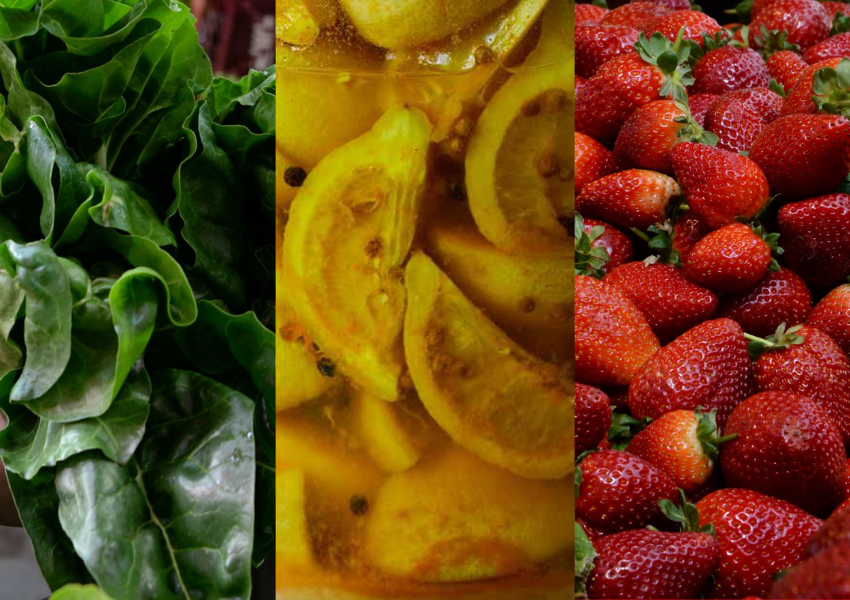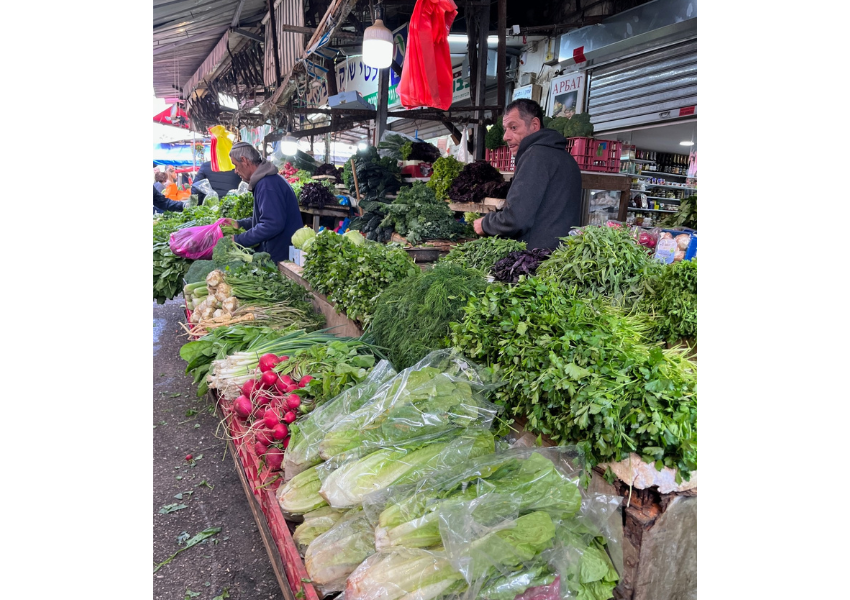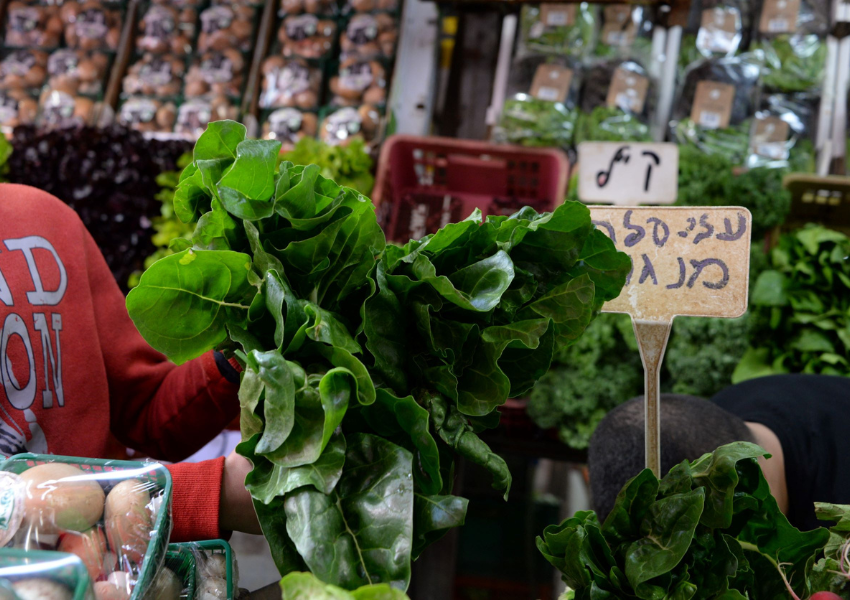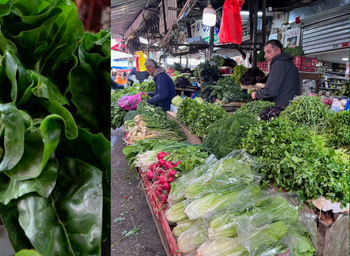Israeli Winter Tricolor

The only reliable season in Israel is summer. Like an annoying relative, it always arrives early and overstays its welcome. Winter plays hard to get. It shows up for a couple of days and disappears for a fortnight. A wise local chef once said: “don’t look for winter in the sky, look for it in the produce crate”. And right he was! Despite the sunny weather, local shuks (Hebrew for markets) brim with the gorgeous bounty of the elusive Israeli winter. The produce stalls are colored green, gold, and red, and I would like to dedicate these columns to this delicious tricolor.
Leafy Greens

Above: Every shade of green at the Carmel market. Photography: Janna Gur.
I remember a visit to a local organic farm in the height of winter. The weather was chilly (for a change), the sky was grey, the earth was muddy, but the fields were a celebration of every imaginable hue of green – light green cabbage, brilliant green lettuce, bottle green broccoli, dark green kale, and so on. True, all of these vegetables are available year round, but they taste and look much better in winter.
In Northern climates, fields go to sleep in winter (often under a blanket of snow). In Israel, this is their time to shine. Mild, cool weather and frequent rain are responsible for the superior taste and texture of almost all fresh produce, not necessarily green. Tubers like kohlrabi (the current darling of the Israeli chefs), beets, and radishes are juicy and crisp, cauliflower is snowy white and so delicious you can eat it raw, and cucumbers are fresh tasting and super crunchy. As we move into spring, fresh artichokes, the beauty queens of the vegetable world, join the celebration.
Introducing Chard

Above: Swiss Chard – two vegetables for the price of one. Photography: Ilan Gur.
Of all the local winter greens, Swiss chard is my favorite. It can do anything spinach can do, but better and with less work (because its leaves are so large). The flavor is slightly tarter than that of spinach, and the texture more robust. With chard, you get two vegetables for the price of one. Juicy muscular stems can survive lengthy cooking and often serve as a base for soups and stews (along with onions, carrots and celery). Leaves are added toward the end of the cooking cycle. Just like spinach, they shrink considerably during cooking, so don’t worry if it seems the recipe calls for too much chard. If you ask me, there is no such thing as too much chard.
Recipe: Meatballs with Tomatoes, Chickpeas, Eggplants, and Chard
Above: Video courtesy of Janna Gur.
This dish evolved gradually in my kitchen. One day, I decided to add some freshly roasted eggplant cubes to the meatballs in tomato sauce that were bubbling on my stovetop. The result was so tasty, they became a regular add on. At some point, a cupful of leftover chickpeas made their way to the pot, adding substance and an additional layer of deliciousness. But the dish really came into its own when a particularly handsome bunch of Swiss chard inspired me to cover the contents of the pot with a “blanket” of coarsely chopped chard leaves.
Ingredients (serves 6-8):
For the meatballs:
1 lb (about 1/2 kg) ground beef
1 egg
3 tablespoons good quality bread crumbs
1 coarsely grated onion
1/3 cup finely chopped cilantro
1 minced garlic clove
1/2 teaspoon cumin
1/4 teaspoon cinnamon
1 teaspoon salt
1/2 teaspoon freshly ground black pepper
For the sauce:
1 large eggplant cut into 1 inch cubes
1/2 cup olive oil
1 tablespoon coarse salt
2 chopped onions
1large bunch Swiss chard, stems and leaves separated and coarsely chopped
4-5 garlic cloves, sliced
2 14-oz (400g) cans crushed tomatoes
1cup chicken stock or water
1 teaspoon cumin
1 teaspoon sugar
Salt and pepper to taste
1 cup cooked or canned (and drained) chickpeas
Instructions:
- Combine all the ingredients for the meatballs. Knead thoroughly and refrigerate for 30 minutes.
- Meanwhile, preheat the oven to 400°F/200°C.
- Arrange the eggplants on a parchment lined baking sheet, drizzle with half of the olive oil, sprinkle with coarse salt, and bake for about 30 minutes until golden-brown.
- Pour the rest of the oil in a large wide saucepan. Add the chopped onions and the chard stems and sauté for 3-4 minutes, until the onions turn translucent. Add the sliced garlic cloves, canned tomatoes, stock (or water), cumin, and sugar. Bring to a boil, reduce the heat to medium-low, and simmer for 10-15 minutes. Don’t add salt yet, as roasted eggplants are quite salty.
- Add the roasted eggplants and chickpeas and simmer for another 5 minutes. Taste and adjust seasoning.
- Wet your hands or rub them with oil, form meatballs the size of a walnut, and slide them into the simmering sauce. The meatballs should be submerged in the sauce. If they are not, add more liquid. Cover and simmer for about 15 minutes.
- Arrange chopped chard leaves on top of the meatballs. Don’t stir, lest you break the delicate meatballs. Simmer for 10-15 minutes until the leaves wilt but still retain their brilliant color. Serve over couscous, rice, or mashed potatoes.
Tip: The dish can be made ahead and reheated, but add the chard leaves shorty before serving.
Janna Gur is a Tel Aviv-based cookbook author, journalist, speaker, and culinary expert.
Reflections
Reflect
Is there any interesting winter fresh produce where you reside? What are they?
Share
What are your favorite Jewish and/or Israeli recipes that include leafy greens?
For chard fanatics:
Are you familiar with chard, and if yes what do you use it for?
Want more?
Get curated JewishArts.org content in your inbox



